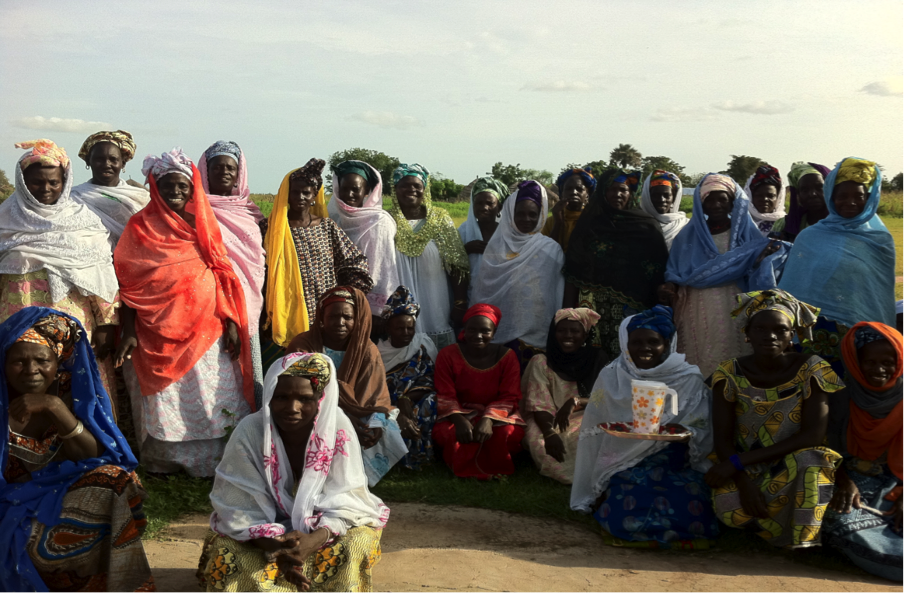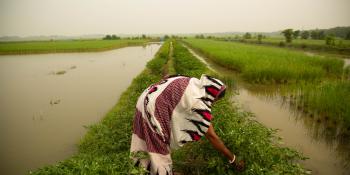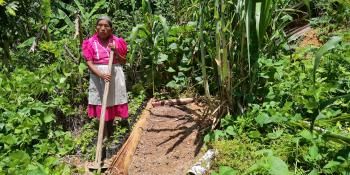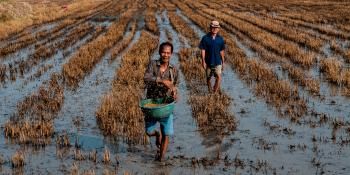One size does not fit all: considering gender, equity and power in climate information services

Study finds gender-specific climate information needs of female vs. male farmers in Kaffrine, Senegal.
Do gender and privilege affect farmers’ abilities to receive and act on climate information services? Based on findings from an ongoing project at the CGIAR Research Program on Climate Change, Agriculture and Food Security’s (CCAFS) research site in Kaffrine, Senegal, the answer to this question is, undeniably, yes.
If you want to know more about research on closing the gender gap in farming under climate change:
- read our special blog series on Closing the gender gap
- watch the presentations and the panel discussion from the Closing the gender gap event
- follow the #AgGenderGap event hashtag on twitter
Smallholder farmers in Africa are already highly vulnerable to climate impacts such as droughts, floods, and storms—and this risk is only increasing. In order to address these risks, CCAFS is partnering with national meteorological agencies, agricultural extension and NGOs to provide tailored climate and weather forecasts to farmers, in the hopes of increasing their preparedness for extreme events and ability to make informed farm management decisions.
But once this information gets to the community level, who actually receives these forecasts, are they truly useful to all farmers?
Community engagement in Kaffrine
From 2011 – 2013, CCAFS researchers worked with farmers in three rural, climate-vulnerable communities in Kaffrine, in Senegal’s central arid peanut basin, to understand their climate information needs beyond existing local knowledge, and the most promising communication methods for reaching them with needed climate services. Through engaging with community members, our researchers identified vulnerable sub-groups within the three target communities. The most vulnerable group turned out to be female farmers, even before youth, elderly and disabled community members.
Gender-specific data was collected to better understand specific vulnerabilities, local capacities and adaptation needs on top of local capacity to cope with climate risk. Results highlighted the fact that vulnerability to climate change is gender-specific, and that female farmers face specific needs when it comes to climate services, in terms of type of information and relevant communication channels.
 Adaptation needs are locally specific: climate information needs of female farmers in Fass Thieken (above) differ from those of female farmers in Dioly village, located only 100 km away. Photo: A. Tall (CCAFS)
Adaptation needs are locally specific: climate information needs of female farmers in Fass Thieken (above) differ from those of female farmers in Dioly village, located only 100 km away. Photo: A. Tall (CCAFS)
If we are to address the needs of all farmers, gender-responsive climate information, communication methods, and adaptation strategies are necessary.
Results from this study are documented in a new working paper.
Meeting climate information needs
Working with Senegal’s national meteorological agency, CCAFS and partners including Senegal Red Cross National Society volunteers then began to communicate a farmer-influenced suite of climate products to the three target communities. These communities had never before received formal climate forecasts.
CCAFS conducted many follow-up discussions with farmers throughout the study to learn which farmers had received the forecasts, how they had received them, and whether or not they found them useful. At the core of this study were these channels for farmer feedback on received climate information established by the project, with the ultimate goal of improved service delivery and salience of the forecasts.
At the end of each rainy season, CCAFS researchers hit the ground and collected farmers’ evaluations of received forecast products through post-season review village meetings. In addition, farmers in each target village were given a community logbook in which to track the performance of received forecasts. Using these logbooks, farmers in the three communities tracked the forecast received, whether or not the forecast event materialized, the amount of precipitation, and any damages resulting from the weather. This data proved very valuable in assessing forecast skill and the overall usefulness of the forecasts for farmers.
Gender-specific climate needs
Focus group discussions with farmers revealed that men and women have very different roles in the community and in agriculture, and these differences account for the large gaps in climate information needs and access. For example, while women often have their own plot of land on which to farm, their male counterparts own the production inputs, such as donkeys, carts, and seeds. Women, therefore, have much less control over when they plant, and usually plant much later in the season than their male counterparts, as they wait for use of the production resources. This means that women harvest much later in the season as well. Because of this, many of the women expressed that they would find it useful to receive information about seasonal rainfall cessation, as opposed to seasonal rainfall onset, which is more useful to men and which global climate research has focused on hitherto. These types of differences existed in each of the three communities.
Gender-specific differences were also found in the endogenous adaptation strategies that women and men farmers resorted to when faced with a climate shock. For example, while both men and women named collective action and reliance on family solidarity as a major coping strategy, women more often cited selling their own assets in order to stay afloat financially when a climate hazard struck.
Men and women farmers also had different preferred outlets for receiving climate information. While rural radio was an important communication pathway for both genders, women named several specific communication methods that the men did not. For example, surveyed women asked that forecasts and early warnings be communicated at the local water borehole, where they gather water every morning, and also named the village “chatterboxes” as strategic places for reaching female farmers.
Addressing gender-specific climate needs at large scale
CCAFS continues to monitor the usage and salience of climate forecasts in these communities, and the forecasts continue to be improved to better meet the needs of the end users. But an important question remains: can these findings be applied at a large scale? Based on an important finding from the study, the answer to this question is no. The results are extremely location-specific and cannot be generalized. Women in each village hold a slightly different role and function under slightly different social constructs.
The conclusion that we can and must apply at a large scale is that climate information services and their communication must be gender-responsive. It is crucial that climate-vulnerable countries develop gender-responsive climate services. To inform the development of such services, the needed time must be spent diagnosing specific needs of female farmers in order to develop tailored services that address their adaptation needs. Otherwise, the burden of climate change will unduly fall on the most vulnerable populations, namely women, who constitute the invisible half of community membership in most areas of Sub-Saharan Africa and South Asia. Community engagement methods as used in this Kaffrine research project offer one potential way forward to understand local gender-specific adaptation needs.
For more information on this work in Kaffrine, please see the report, Who gets the information? Gender, power and equity considerations in the design of climate services for farmers
Learn more about CCAFS' work on gender and climate services:
Is gender being considered within climate services?
Sarah Lynagh is a research assistant with CCAFS, based at the International Food Policy Research Institute (IFPRI).
Arame Tall is a climate services scientist with CCAFS, based at IFPRI.
Alexa Jay is a communications specialist with CCAFS, based at the International Research Institute for Climate and Society.
All authors work with the CCAFS Research Theme on Climate Risk Management.



